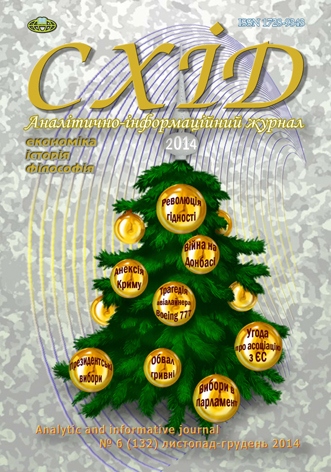Electronic commerce as a means for meeting on-line market demand
DOI:
https://doi.org/10.21847/1728-9343.2014.6(132).36412Keywords:
electronic commerce (e-commerce), informatization, virtualization, on-line marketAbstract
Virtualization of economic processes has greatly changed the interrelation pattern of consumers and producers. As a result of such changes, a potent virtual market of goods and services was developed, which is used by almost half of active Internet users who in their turn make nearly half of the world population. Those changes in users' awareness as to culture of consumption and purchase began to constitute a certain threat to so-called physical markets which lost some clients in favor of virtual markets.
The author proves that expanded access to the Internet has changed the trading system by moving its part from the physical market onto the on-line platform, which in its turn has restructured the interrelation pattern of business process actors, namely consumers and producers. Due to the fact that the boundaries between the on-line and off-line commerce had become diffuse, numerous consumers changed the method of ordering goods and services by beginning to use the Internet platform, which in its turn gave impetus to a dynamic growth of the electronic commerce sector. It is established that the growth of the e-commerce market results from the increasing demand for a simplified system of access to the 24/7 trading sites, which allows to not only compare variations of the selected products with similar ones and buy them but also select the delivery through a preferred logistical chain in the on-line mode.
It is established that through computerization of the selection the consumer has become an active participant of the exchange process by integrating into marketing communications owing to which the producer gets feedback and has to respond to consumer's specific needs. In general, transformation of the contemporary market involves virtualization of interrelations between the consumer and the producer.Downloads
References
Pokrovskaya L. L., Kopachev A. A. (2010), E-commerce in the field of information services, Saint Petersburg, 151 p. (rus).
Yudin O. M., Makarova M. V., Lavreniuk R. M. (2011), E-commerce: the creation, advancement and development, Poltava, 201 p. (ukr).
2013 UPS Pulse of the Online Shopper, available at: http://pressroom.ups.com/pressroom/staticfiles/pdf/fact_sheets/2013_PulseShopper_FINAL.pdf (engl).
Consumer Barometer, available at: https://www.consumerbarometer.com/en/ (engl).
Dan C. (2014), Consumer-To-Consumer (C2C) Electronic Commerce: The Recent Picture, International Journal of Networks and Communications, 4 (2), pp. 29-32 (engl).
Dholakia N., Fritz W., Dholakia R. R., Mundorf N. (2002), Global E-commerce and Online Marketing: Watching the Evolution, Greenwood Publishing Group, 316 p. (engl).
e-Commerce Models, available at: http://www.eservglobal.com/uploads/files/index.pdf (engl).
Nemat R. (2011), Taking a look at different types of e-commerce, World Applied Programming, Vol (1), No (2), pp. 100-104 (engl).
The Global Information Technology Report 2014, available at: http://www3.weforum.org/docs/WEF_GlobalInformation Technology_Report_2014.pdf (engl).
Pillar F. The Customization 500: An International Benchmark Study on Mass Customization and Personalization in Consumer E-Commerce, available at: http://mass-customization.blogs.com/mass_customization_open_i/mc500study.html (engl).
Plant R. (2000), Ecommerce: Formulation of Strategy, Prentice Hall Professional, 343 p. (engl).
Price waterhouse Coo, available at: http://www.pwc.com/ua/uk/index.jhtml (engl).
The Global Information Technology Report 2014, available at: http://www3.weforum.org/docs/WEF_GlobalInformation Technology_Report_2014.pdf (engl).
The Statistical Portal Statista, available at: http://www.statista.com/statistics/261676/digital-buyer-penetration-worldwide/ (engl).
The World Bank. Data. Internet users (per 100 people), available at: http://data.worldbank.org/indicator/IT.NET.USER.P2 (engl).
Downloads
Published
How to Cite
Issue
Section
License
Copyright (c) 2015 Tetiana Kurant

This work is licensed under a Creative Commons Attribution-NonCommercial-NoDerivatives 4.0 International License.
1. Authors bear responsibility for the accuracy of facts, quotations, numbers and names used.
2. Manuscripts are not sent back.
3. The publisher does not always agree with the authors' opinion.
4. The authors reserve the right to authorship of the work and pass the first publication right of this work to the journal under the terms of a Creative Commons Attribution-NonCommercial-NoDerivatives 4.0 International License. This license allows others to distribute (copy) the published work for non-commercial purposes, provided there is mandatory attribution to its authors and a link to the first publication in our journal.
5. The authors have the right to conclude separate supplement agreements that relate to non-exclusive work distribution in the form in which it has been published by the journal (for example, to upload the work to the online storage of the journal or publish it as part of a monograph), provided that the reference to the first publication of the work in this journal is included.

